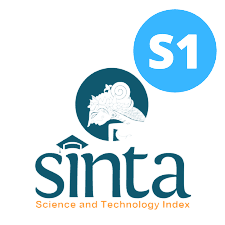The Impact of Solvent Composition and Copper (Cu) Ion Doping on Dye Anthocyanin on Increasing Dye-Sensitized Solar Cell (DSSC) Efficiency
Abstract
The development of Dye Sensitized Solar Cells (DSSC) is increasing fast because fabrication costs are more affordable than silicon solar cells. In this study, anthocyanin pigments were used as a natural dye source. Anthocyanins are a group of flavonoids that can be extracted most proficiently in acidic conditions; therefore, variations in the composition of solvents and acids significantly impact anthocyanin yield. The anthocyanin pigments in this study were extracted from dragon fruit peels using a maceration method with variations in methanol composition and the addition of hydrochloric acid or citric acid (3/0; 3/0.5; 3/1). This study aims to improve the efficiency of DSSC by varying the solvent composition and adding Cu ion doping. The characterizations include measurement of absorbance, functional group, and efficiency using UV-Vis Spectrophotometer, Fourier Transform Infrared (FTIR), and current-voltage, respectively. The results show that anthocyanin dye with a composition of methanol/acid (3/0) and the addition of Cu ion produced the highest absorbance value and efficiency of 0.4102 Ω-1m-1 and 0.016%, respectively.
Keywords
Full Text:
PDFReferences
- Kumara, N. T., Andrey, L., Chee, M. L., Mohammad, I. P., & Piyasiri, E. 2017. Recent progress and utilization of natural pigments in Dye Sensitizer Solar Cell : A Review. Renewable and Sustainable Energy Review, 78, 1-17.
- Madnasari, S., Hadi, S., Wulandari, R. S., Yulianti, Edi, S. S., & Prastiyanto, D. 2020. Performance stability and optical properties of Musa Acuminata bracts as based Dye-Sensitized Solar Cell. Materials Today : Proceedings, 13, 311-316.
- Chien, C. Y., & Shu, B. D. 2013. Optimization of the dye-sensitized solar cell with anthocyanin as photosensitizer. Solar Energy, 98, 203-211.
- Prabavathy, N., Shalini, S., Balasundaraprabhu, R., Velauthapillai, D., Prasanna, S., Walke, P., & Muthukumarasamy, N. 2017. Effect of solvents in the extraction and stability of anthocyanin from the petals of Caesalpinia pulcherrima for natural dye sensitized solar cell applications. Journal Mater Sci: Mater Electro, 28, 9882–9892.
- Subalakshmi, K., Senthilselvan, J., Kumar, K. A., Kumar, S. A., & Padurangan. 2017. Solvothermal synthesis of hexagonal pyramid and bifrustum shaped ZnO nanocrystals: natural betacyanin dye and organic eosin Y dye sensitized DSSC efficiency, electron transport, recombination dynamics and solar photodegradation investigations. In Jurnal of Materials Science : Materials in Electronics, 28(20), 15565-15595.
- Gokilamani, N., Muthukumarasamy, N., Thambidurai, M., Ranjitha, A., & Velauthapillai, D. 2013. Utilization of natural anthocyanin pigments as photosensitizers for dye-sensitized solar cells. Journal Sol-Gel Sci Technol, 66, 212-219.
- Pratiwi, D. D., Nurosyid, F., Kusumandari, Supriyanto, A., & Suryana, R. 2017. Performance improvement of dye-sensitized solar cells (DSSC) by using dyes mixture from chlorophyll and anthocyanin. Journal of Physics: Conference Series, 1-6.
- Amogne, N. Y., Ayele, D. W., & Tsigie, Y. A. 2020. Recent advances in anthocyanin dyes extracted from plants for dye sensitized solar cell. Materials for Renewable and Sustainable Energy, 9(23), 1-16.
- Chang, H., Kao, M. J., Chen, T. L., Chen, C. H., Cho, K. C., & Lai, X. R. 2013. Characterization of Natural Dye Extracted from Wormwood and Purple Cabbage for Dye-Sensitized Solar Cells. International Journal of Photoenergy, 1-8.
- Omar, A., Ali, M. S., & Rahim, N. A. 2020. Electron transport properties analysis of titanium dioxide dye-sensitized solar cells (TiO2-DSSCs) based natural dyes using electrochemical impedance spectroscopy concept:Arevie. Solar Energy, 207(1), 1088-1121.
- Kabir, F., Sakib, S. N., & Matin, N. 2019. Stability study of natural green dye based DSSC. Optik, 181, 458-464.
- Al-alwani, M. A., Mohammad, A. B., Ludin, N. A., Kadhum, A. A., & Sopian, K. 2016. Dye-sensitized solar cell : development, structure, operation principles, electron kinetics, characterisation, synthesis materials and natural photosensitisers. Renewable and Substainable Energy Reviews, 65, 183-213.
- Fadli, U. M., Ardimas, Supriyanto, A., Cari, & Prasada, A. B. 2021. Efek penyisipan Cu ke dalam dye beras hitam dengan luasan 0,5 cm2 pada dye sensitized solar cell (DSSC). Jurnal Matematika&Sains,1(1),41-48.
- Çakar, S. 2019. 1, 10 phenanthroline 5, 6 diol metal complex (Cu, Fe) sensitized solar cells: A cocktail dye effect. Journal of Power Sources, 435, 226825.
- Lin, Q., & Wang, J. 2019. Dye-sensitized solar cells based on surficial TiO2 modification. Solar Energy, 183, 454-465.
- Prasada, A. B., Fadli, U. M., & Supriyanto, A. 2016. Dye Oriza sativa glutinosa doped Fe as a active element of Dye Sensitized Solar Cell (DSSC). In Journal of Physics: Conference Series ,776.
Refbacks
- There are currently no refbacks.
















